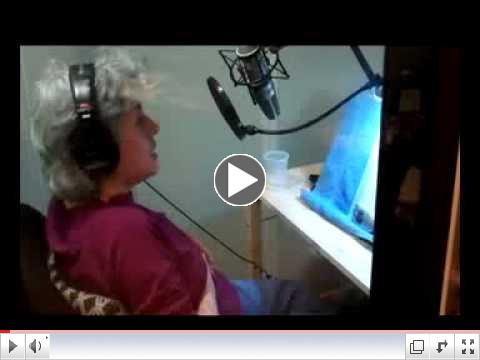New release! Available now!
Mirror Mirror: A Book of Reversible Verse
By Marilyn Singer
Illustrated by Josee Masse
Read by Marilyn Singer & Joe Morton
Music by Chris Kubie
 |
| Mirror Mirror-Live Oak Media-Marilyn Singer.mp4 |
From the princess to the frog, from beauty to the beast, from Sleeping Beauty to the prince, author Marilyn Singer and actor Joe Morton tell both sides to each story in the 14 pairs of poems that comprise this delightful collection. Each poem can be read in two ways: up and down; each is a reverse image of itself. Based on favorite fairy tales, the clever text is matched with brilliant artwork that offers split images, giving insight into the meaning of each poem. The magic of language and fairytales is further enhanced with lyrical background music that also draws on the use of the "reverso."
The man behind the music...
Chris Kubie, who has been creating musical compositions for Live Oak Media readalongs for over 20 years, is a film composer whose music has appeared on HBO specials, the Art and Entertainment Network, PBS, the Discovery Channel and the Learning Channel. Chris also provides music for independent film projects, as well as composing and producing music for literally hundreds of audio and video productions adapted from great books. http://www.chriskubie.com
The recent production MIRROR MIRROR provided a terrific opportunity for us to showcase Chris's invaluable contributions to our readers.
LOM: MIRROR MIRROR is a book of poems, based on fairytales, called "reversos". You created beautiful, lyrical music that further reflects this approach? Tell us how you were able to accomplish this musically?
C.K.: I reversed the phrases musically as done in the poems, though some liberty was taken, such as one poem in a major key, the "reverso" of it in the relative minor key, or using alternate chords because the punctuation and mood of each reversed poem was somewhat or even completely different. The music had to reflect the ever-contrasting moods first and foremost. So the idea of reversing the musical phrases, while a good idea, was not used strictly.
LOM: When you first receive a book, what is the process you go through to prepare to create the music, and how does the creative process unfold for you?
C.K.: I like to dive into the book to get a feeling for it before we even discuss the project. Sometimes ideas come right away, more often they creep up when you least suspect. The next step is a "spotting session". Here the production team discusses our feelings about the project in general terms. Later we go page by page, line by line, and over each illustration, deciding where music is needed and how it should serve and enhance the story. Then the real work for me begins -- creating these musical cues in a way that supports, sustains and enhances the mood of the text and illustrations, bringing emphasis to the story's emotion and/or setting the scene.
All this must be done in a way that enhances without causing distraction, or too much attention to the music itself. A lot of time is spent roughing-in the music to be sure it is cohesive before I even begin fleshing out the orchestration. To my knowledge, Live Oak Media productions stand alone in producing children's audio with original and fully orchestrated music, created specifically for each project. Live Oak Media raises the bar!
LOM: How has your approach and/or the process evolved over the years?
C.K.: The musical process from both a technical and compositional standpoint has evolved immensely. In the early years of Live Oak Media the music wasn't a significant part of the production. We would use public domain music, which was chosen at the session, then recorded at the session --done! I think it was the recording of Gail Gibbons' WHALES that was the first production where my original music was used. But it was time to raise the bar. Children's expectations had evolved and their tastes were becoming more sophisticated at a young age, so the music became more "sonic illustration" than just incidental punctuation.
LOM: What have been some of your favorite books to score? And why?
C.K.: I love different projects for different reasons. For just being entertaining and funny, it's hard to top Doreen Cronin and Harry Bliss's DIARY OF A FLY , or DIARY OF A SPIDER, or DIARY OF A WORM. Anything Harry Bliss has been associated with, including Kate DiCamillo and Harry Bliss's 2010 AUDIE Winner LOUISE, THE ADVENTURES OF A CHICKEN. It's fun working on this colorful, zany stuff!
For stimulating children's appreciation and stewardship of our planet, nothing comes close to the work of my dear friend Jean Craighead George, especially when combined with Wendell Minor's beautiful art: LUCK, THE BUFFALO ARE BACK, and THE WOLVES ARE BACK.
Vera B. Williams' ALA Notable Children's Recording, AMBER WAS BRAVE, ESSIE WAS SMART is beautiful, sweet and has a great cast including the wonderful Barbara Rosenblat, Carine Montbertrand, and Tony award-winner Daisy Eagan.
Sarah Stewart & David Small's THE MONEY TREE, THE FRIEND, and THE LIBRARY -- who says children's books are just for children?
I quote Uri Shulevitz' s ALA Notable Children's recording SNOW all winter long, especially this last winter! I loved writing that music. Watch the DVD.
I have omitted so many all-time favorites, forgive me all, but I can not forget Mordicai Gerstein! THE MAN WHO WALKED BETWEEN THE TOWERS
Lastly this; at my father's memorial service some years ago I recited FISHING IN THE AIR by Sharon Creech. Such a beautiful book on so many levels. I barely made it through this reading, it was so emotional for me, and likewise, Sharon's words touched all who knew my father, in some way.
My work for Live Oak Media has kept me young at heart for about a quarter of a century.